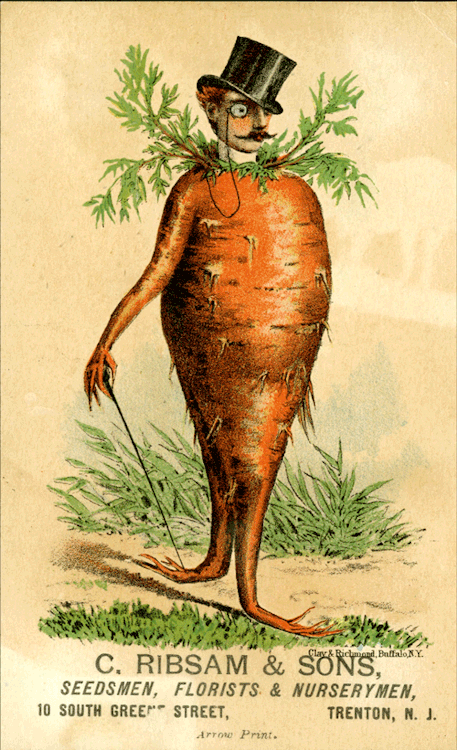#smithsonian libraries
Carrot top of the morning to you.
In the Victorian era, whimsical seed cards like this one were all the rage, inspiring people to buy seeds and collect the cards that came with them.
Along with being collectors’ items, seed and nursery cards document the history of U.S. agricultural business and advertising. They tell a story about how American gardening has been shaped by history, social attitudes, the environment and innovation.
What story do you think this gentleman would tell?
Dig into history in our new exhibition “Cultivating America’s Gardens” from @smithsonianlibraries and@smithsoniangardens, open through August 2018 at our National Museum of American History.
Post link
Friday plans include a cold beverage? Meet the beer fridge of 1899.
It’s from a catalog of by L. H. Mace & Co. of New York, now in our @smithsonianlibraries. Early refrigerators used insulation (with an inch between two sets of walls) and circulation to move cool air from the ice chamber throughout the space.
Inside this refrigerator, there were places for kegs to rest and shelves in the lower part of the refrigerator could be removed, making it possible to chill two more kegs.
Post link

️ Happy Pride Month! ️
Insects are some of the most colorful and diverse species of all biodiversity. These moths and butterflies are by Emile-Allain Séguy for his Papillons (1925). Seguy’s work shows his deep interest in the study of insects as well as his artistic expression in these remarkable designs, which were likely intended for textiles or wallpaper.
Figures 1 and 2: Madagascan sunset moths (Chrysiridia rhipheus)
Figure 3: Green-banded Urania moth (Urania leilus)
Figures 4 and 5: Red flasher butterflies (Panacea prola zaraja)
View in Biodiversity Heritage Library (@biodivlibrary) with thanks to Smithsonian Libraries and Archives (@smithsonianlibraries) for digitizing.

Happy Amphibian Week!
Amphibian Week wouldn’t be complete without sharing Ernst Haeckel’s study of frogs from his Kunstformen der Natur(1899).
View more in Biodiversity Heritage Library with thanks to Smithsonian Libraries for digitizing.

Happy Amphibian Week!
Fire salamanders (Salamandra salamandra) are found throughout Europe.
SciArt by J. Green for the Proceedings of the Zoological Society of London(1911).View more in the Biodiversity Heritage Library (@biodivlibrary) with thanks to the Smithsonian Libraries and Archives (@smithsonianlibraries) for digitizing.

Happy Frog Friday!
Gliding leaf frogs (Agalychnis spurrelli) are nocturnal natives of tropical rainforests in Central and South America.
SciArt by J. Green for the Proceedings of the Zoological Society of London (1913). View more in the Biodiversity Heritage Library with thanks to the Smithsonian Libraries and Archives for digitizing.

Happy Feathursday!
Barn swallows (Hirundo rustica). On the right is the subspecies that can be found in Egypt.
SciArt from Naturgeschichte der Vögel Mitteleuropas, Vol. 4 (1901). View more in the Biodiversity Heritage Library with thanks to the Smithsonian Libraries and Archives for digitizing.

Look at this CHONK!
Common Atlantic octopus(Octopus vulgaris).
SciArt by L. Bintot for British Conchology, Vol. 5 (1869) by John Gwyn Jeffreys.
Viewin Biodiversity Heritage Library (@biodivlibrary) with thanks to Smithsonian Libraries and Archives (@smithsonianlibraries) for digitizing.

Happy Feathursday!
Eurasian spoonbill(Platalea leucorodia).
SciArt by Elizabeth Gould and John Gould for The Birds of Europe, Vol. 4 (1837). View more in the Biodiversity Heritage Library with thanks to the Smithsonian Libraries and Archives for digitizing.

Happy World Bivalve Day!
Do you ❤️ molluscs? Then this heart cockle(Corculum cardissa) is for you!
SciArt from General Conchology (1815) by William Wood. View more in the Biodiversity Heritage Library (@biodivlibrary) with thanks to Smithsonian Libraries and Archives (@smithsonianlibraries) for digitizing.

Marbled Monday
An impressionistic view of a starry night through treetops.
Marbled endpaper found in The North American Sylva, Vol. 2 (1853). View more in the Biodiversity Heritage Library @biodivlibrary with thanks to the Smithsonian Libraries and Archives @smithsonianlibraries for digitizing.



Happy Feathursday!
This week features a trio of nests with blue eggs from the marvelous Illustrations of the Nests and Eggs of Birds of Ohio, Vol. 1 (1886).
Top:Grey Catbird(Dumetella carolinensis) by Virginia Smith Jones.
Middle:American Robin(Turdus migratorius) by Eliza Jane Shulze.
Bottom:Wood Thrush(Hylocichla mustelina) by Genevieve Estelle Jones.
View more of these beautifully detailed eggs and nests in the Biodiversity Heritage Library (@biodivlibrary) with thanks to the Smithsonian Library and Archives (@smithsonianlibraries) for digitizing.

Violets
Genus Viola.
SciArt by Marie Low for the Flower Grower’s Guide, D.1 (1898).
Viewin Biodiversity Heritage Library (@biodivlibrary) with thanks to Smithsonian Libraries and Archives (@smithsonianlibraries)fordigitizing.

Happy Tree Tuesday!
Trees are homes for all kinds of birds, and this illustration shows a heronry, also known as a heron rookery. Heronries are large nesting sites for dozens of herons. This forest in particular was estimated to host between 200 to 400 nesting pairs of grey herons (Ardea cinerea) at the time of the photograph!
SciArt by John Gerrard Keulemans entitled “Heronry in Great Sowden Wood, Sussex”, which he based on a photograph taken 18 August 1877, and completed for Ornithological Miscellany, Vol. 3 (1878), edited by George Dawson Rowley. View more in the Biodiversity Heritage Library (@biodivlibrary) with thanks to Smithsonian Libraries and Archives (@smithsonianlibraries) for digitizing.


